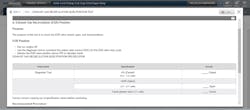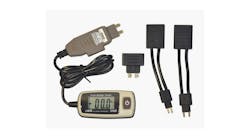Editor's Note: This article was orginally published June 15, 2018. Some of the information may no longer be relevant, so please use it at your discretion.
Even though today's turbochargers still perform basically the same function as those from the past, the technology has undergone significant changes in the past few years. Some of the changes include controlling the amount of boost they are able to produce either by an electronically controlled waste gate, or by changing vanes within the turbo, thereby effectively changing the size of the turbo to better match the needs of the engine.
All of this means that when a turbo issue arises, you will need to follow roughly the same path to diagnose the system as you would with most other electronic computer-controlled systems. There are steps you can take to assure a complete repair and make the job easier when it comes to repairing or replacing a turbo.
Step 1 – Obtain vehicle information
Start by collecting details of the issue from the customer's perspective. This may provide you with valuable clues as to what type of issue is going on, along with information about any prior repairs that may have been done. This customer told us the check engine light has been an ongoing issue, and they had spent quite a bit of money attempting to repair it at other shops. Some of the parts replaced included the turbo (twice), charge air cooler and MAP sensor, all within the past year.
The next part of obtaining information if previous repairs have been done is to ask for repair orders from the other shops. This ensures the information provided by the customer is accurate, and you can see what data was provided by the technician who had performed the previous work. It’s possible the existing issue is unrelated to previous issues, and having as much information as possible from previous repairs could save quite a bit of time and help clear up misinformation from the customer.
In this case, the information available on the repair orders was not very useful as the technician’s notes regarding diagnostic findings were very limited. The repair orders did show a common symptom of a P0299 DTC present for each repair.
At this time, obtaining fault codes will allow you to determine your next steps. Connect your scan tool and obtain current, historical and pending codes. I also suggest you look to see if all monitors have run. This may help you to ensure the vehicle will not return after a short time with the check engine light on again.
Many times, a monitored system may not be able to complete its tests if there is a DTC. If there is a fault in the system that was unable to complete its monitor tests, the check engine light will illuminate once the repair is done, and that monitor can run.
On this F-250, a scan showed a P0299 with all monitors complete and no pending codes.
We looked up the P0299 code on Mitchell 1 in order to look for any TSBs, and also to determine the conditions for setting the code. Many times you can find uncommon causes of an issue by completely understanding all of the components and the operating parameters of the system you are working on. Mitchell 1 has added a useful feature in their database which can provide you with a list of common repairs associated with the code or codes. This does not mean you can skip testing components and performing a complete diagnostic process, but it may lead you to test some components you may not have considered.
Step 2 – Perform a complete diagnosis
Since this truck seemingly has an ongoing or recurring issue with the turbo, we’ll need to take some extra time to do a thorough diagnosis. A critical step will be to observe the freeze-frame data on your scan tool. This will provide you with the sensor data during the time the code was set. Document the data, then clear the code and drive the vehicle under the same conditions that were present when the code was set. If the condition still exists, the code, either pending or current, will reset.
It is important to take the time to perform these steps, not only to duplicate the problem and make sure it’s not an intermittent issue, but also to rest assured once repairs have been made that you have accomplished a complete repair by driving the vehicle again under the same conditions that triggered the code.
We drove the vehicle under the same conditions found within the freeze-frame data and the engine light quickly illuminated and stored a P0299 code. We also noted there did not appear to be any lack of performance.
The engines computer system (ECM) uses sensors to monitor boost (intake manifold pressure), exhaust temperature, exhaust back-pressure and, in the case of a variable geometry turbo, vane position. The ECM then compares data from the sensors to known values that should exist at the current engine operating conditions. If the boost pressure does not match a “known good value” for the current operating conditions, a low boost turbo performance code will set. These codes can be set by faulty sensors or low boost.
Proper turbocharger operation relies on exhaust heat and pressure to spin the turbo to the speed necessary to obtain the boost pressure to match the demands of the engine. Any leak in the inlet (engine exhaust side) of the turbo may cause a lack of turbo shaft speed. Leaks on the outlet (engine intake side) will cause a loss of pressure getting to the engine. In order to determine if there are any leaks present in either the inlet or outlet parts of a turbocharger system, a diagnostic smoke tool should be used. Turbo systems have the ability to generate relatively high pressure, therefore a traditional smoke machine used for other smoke testing may not show leaks that are only present under higher boost conditions. Additionally, exhaust systems used on turbocharged engines are generally larger, and using a small volume smoke tester could take some time to discover a leak in the exhaust system.
We have found that using the PowerSmoke Pro from Redline Detection to test intake and exhaust systems on turbocharged and heavy duty engines to be the best way to find even the smallest of leaks. The high pressure, high volume system allows us to find leaks much quicker than any other tester we have used. There are a few other uses for using a smoke machine when diagnosing a turbo system, but we’ll get to that shortly.
When using the smoke machine, spend a little extra time checking for leaks at connections at the charge air cooler and all exhaust connections. Even the smallest leaks at these connections can affect boost pressure. This Ford had a few small leaks that we were able to repair by tightening connections.
Having experience with many Ford trucks with 6.0L engines, we have seen numerous issues with the variable geometry turbo. This system utilizes a control solenoid to allow oil pressure to move vanes within the turbo. This effectively makes the turbo smaller or larger, allowing boost pressure to match the operating conditions of the engine at all times. One common issue is caused by the oil control solenoid sticking. This is usually caused by poor maintenance on oil change intervals or using the incorrect oil. Another common problem is caused by carbon building up in the turbo preventing the vanes from moving freely. The easiest way to test this is to remove and dismantle the turbo, then clean the carbon.
Any exhaust system parts, especially turbos, have a tendency to have problems with their removal, mostly due to retaining bolts breaking. High exhaust temperatures can cause bolts to stick, and in some cases, become brittle, which may cause them to break upon their removal. We have found the Mini Ductor series of tools from Induction Innovations to be extremely helpful in saving time by reducing the number of times a bolt breaks upon removal. This tool usually takes less than five minutes to prep and heat up exhaust bolts, allowing easy removal without breaking or stripping threads. The tool has many other uses beyond exhaust systems, including preparing removal of stubborn suspension and brake mounting hardware. We removed and dismantled the turbo and found no issues with either the vanes or their control.
Further research in Mitchell 1 indicated EGR issues can cause turbo performance codes. For instance, if an EGR were to stick open, manifold pressure will be reduced causing the ECM to trigger a fault code by recognizing a drop in expected MAP pressure. Also, an EGR that is plugged may cause a fault code because the expected boost pressure is calculated to a correctly functioning EGR system.
We observed the PIDs for EGR position on the scan tool and found them within specifications. Next, we removed the EGR valve to determine if there were any restrictions in that system.
Here is another way to use the smoke tester: connect the tool to the throttle body. There should be a steady stream of smoke from the intake port of the EGR valve when pressure is applied. In this case there was steady smoke indicating no issue. Apply smoke to the exhaust system while observing the exhaust port of the EGR valve; this should create smoke from the port. This is where we found our issue: there was relatively no smoke coming from the port, indicating a restriction in the system.
Step 3 – Repairing the vehicle
Since we could not find any problems in any part of the turbocharger other than the EGR system, we obtained authorization from the customer to replace the EGR valve and cooler and clean the intake manifold. Closer inspection of the cooler showed a significant buildup of carbon, which is usually caused by a faulty cooler. Our policy is that once we remove exhaust or cooling system bolts, we replace the bolts with new ones and use a thread cleaning tap to remove any rust or carbon from the threads in their respective holes. We also use an anti-seize thread lubricant, making sure if the bolts need to be removed again, there will be less chance of having issues.
Step 4 - Verify the repair
Once the EGR cooler was replaced, we checked flow again with the smoke tester and found no restrictions. We re-installed the turbo and EGR valve, then drove the vehicle using the previous freeze frame data to make sure the fault codes did not return. Remember -- the vehicle will need to be driven for a relatively long road test in order for all of the monitors to run. Only then can we verify no faults exist.
Take a little extra time to perform a thorough diagnosis and to prepare components for removal to make sure you’ve performed a complete repair and have few problems replacing parts.


